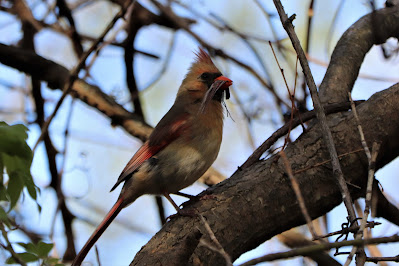Birds With Sticks!
Spring time brings the opportunity to see nest building in action. Over the past few weeks, I have watched several bird species collect nesting material.
The Northern Cardinal nest is usually well hidden in dense shrubs, vines, or low trees. The open cup made of twigs, weeds, grass, and leaves, lined with fine grass or hair is made by the female. (Audobon Field Guide)
A House Wren tried unsuccessfully to pull a twig into the nest box. The next day, I could see the stick was still half way in the box. The nest inside the cavity is built into a depression in the twigs and lined with feathers, grasses, animal hair, spider egg sacs, string, snakeskin and discarded plastic. (Cornell Lab, All About Birds)
Most people are familiar with the rounded cup shape of an American Robin's nest made from mud and grasses. This Robin has managed to stuff his beak so full of grasses that it looks like he has a moustache!
A pair of Coopers Hawks is again nesting in Canatara Park. This is the second nest I have seen that was built by placing sticks on top of an old squirrels nest.
I was photographing this Tree Swallow with a stick when the male showed up and I captured the next photo: I don't know enough about Tree Swallows to know if the stick is a normal step in the courtship process but LOVE was certainly in the air!





















































